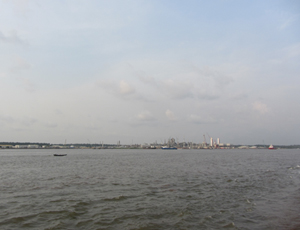
Africa hopes to ramp up its liquefied natural gas (LNG) capacity by an additional 88.7 metric tonnes per year by 2020, despite the withdrawal of leading U.S. energy company Chevron Corp. from one of the largest liquefaction plants on the continent.
The withdrawal of California-based Chevron from the Olokola LNG project in Nigeria has not dampened the appetite of many North American and European-based companies eyeing Africa’s LNG market, both in production and construction of liquefaction plants, to grow their investment portfolio and profits, according to London-based professional services firm Ernst & Young.
The firm says North American and European oil and gas companies, including Chevron, Anadarko, Marathon Oil, BG Group and ENI, have a competitive advantage in Africa, with estimated natural-gas-proven reserves of 14 trillions cu meters (Tcm), because of “their financial might and their deep technical capabilities and operational experience.”
Chevron's pulling out of the Nigerian project leaves Africa hinging its hopes on Angola, Algeria, Mozambique and Tanzania to expand its liquefaction capacity, local consumption and exports in 2013, according to Ernst & Young. The accounting firm says the additional 88.7 MT per year will supplement the existing operating capacity of 71.7 MT per year (MTPY).
Chevron, which is the third-biggest energy producer in Nigeria, confirmed in August it was pulling out of the LNG project, citing reluctance by Nigeria’s federal government to reach a final investment decision on the project as well as a delay in the passage of the Petroleum Industry Bill (PIB). The petroleum bill would give the country's president authority to award exploration and production licenses without competitive bidding and would give Nigeria's petroleum minister the authority to set how much oil and gas developers in the country would pay in royalties, penalties and rentals based on their output.
Andrew Fawthrop, the company’s chief executive for the Nigerian unit, explained in a statement to the media that Chevron had taken the decision to pull out based on “a review of our investment decision, the lack of progress on the project and a reprioritization of resources to focus on growing domestic gas supply.”
“Chevron is fully committed to Nigeria and continues to pursue its investment in the country’s oil-and-gas industry,” added Deji Haarstrap, general manager, policy, government and public affairs.
The U.S. oil-and-gas company had a 23% stake in the project, up from the initial 19.5%, after taking up BG Group’s interest when it pulled out earlier in June 2012. Chevron became the third partner to pull out after BG Group and Shell, which quit in July of this year.
Nigeria Liquefied Natural Gas (NLNG) on Bonny Island is the only LNG complex operational in the West Africa country. It has six trains; a seventh is under construction, with a completion date well beyond 2014 because of a poor regulatory environment, political interference and delayed action on PIB.
Nigeria has an estimated 180 trillion cu ft (Tcf) of proven natural-gas reserves, the ninth largest in the world and the largest in Africa but produces a mere 1 Tcf of dry natural gas over what the U.S. government’s Energy Information Administration (EIA) says are regulatory and security challenges in the country’s gas-rich Niger Delta.
Analysts, however, say that, despite the challenges facing the construction of Nigeria’s Olokola project, Africa, with an annual natural-gas consumption of 110 billion cu m (Bcm), is poised to grow its production and exports of LNG in the coming months because of the “low domestic demand and proximity to Asian markets.”
Jerome Ferrier, the president of the International Gas Union (IGU), says in the new "World LNG Report 2013" that more projects lined up in Angola, Algeria, and South Africa and, later, in Mozambique and Tanzania could push natural-gas exports from Africa beyond the 23.7 MT shipped out in 2012.


Post a comment to this article
Report Abusive Comment